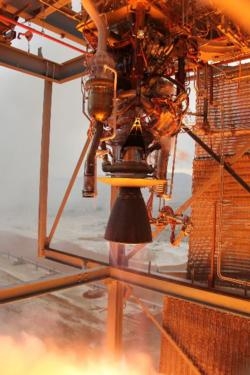Fri, Apr 17, 2015
Will Boost New Shepard Suborbital Flight
Blue Origin recently completed acceptance testing of its BE-3 rocket engine, the first new hydrogen engine to be developed in the United States in more than a decade. The 110,000-lbf BE-3 will power Blue Origin’s New Shepard suborbital system, and later, will be modified for upper stage applications.

"The BE-3 has now been fired for more than 30,000 seconds over the course of 450 tests,” said Jeff Bezos, Blue Origin founder. “We test, learn, refine and then test again to push our engines. The Blue Origin team did an outstanding job exploring the corners of what the BE-3 can do and soon we’ll put it to the ultimate test of flight.”
The BE-3 can be continuously throttled between 110,000-lbf and 20,000-lbf thrust, a key capability for vertical takeoff and vertical landing vehicles. The testing profile included multiple mission duty cycles, deep throttling and off-nominal test points.
“Liquid hydrogen is challenging, deep throttling is challenging and reusability is challenging," said Bezos. “This engine has all three. The rewards are highest performance, vertical landing even with a single-engine vehicle and low cost. And, as a future upper stage engine, hydrogen greatly increases payload capabilities.”
The BE-3 engine was designed and fabricated at Blue Origin’s design, development and production facility in Kent, Wash. Full-engine testing was conducted at the company’s facilities in West Texas, while earlier combustion chamber testing was completed at NASA’s Stennis Space Center in Mississippi.
The BE-3 is the third generation of Blue Origin-developed engines. The fourth-generation BE-4 uses liquid oxygen and liquefied natural gas (LNG) to produce 550,000-lbf thrust at sea level. Under development since 2012, the BE-4 provides the lowest cost and fastest production path to power the nation’s access to space. Selected by United Launch Alliance to serve as the primary propulsion provider for its Next Generation Launch System, Blue Origin is developing the BE-4 as an integrated part of America’s newest launch vehicle.
(Image provided by Blue Origin)
More News
Light Gun A handheld directional light signaling device which emits a brilliant narrow beam of white, green, or red light as selected by the tower controller. The color and type of>[...]
"The journey to this achievement started nearly a decade ago when a freshly commissioned Gentry, driven by a fascination with new technologies and a desire to contribute significan>[...]
Aero Linx: JAARS, Inc. For decades now, we’ve landed planes on narrow rivers and towering mountains. We’ve outfitted boats and vehicles to reach villages that rarely se>[...]
"Our driven and innovative team of military and civilian Airmen delivers combat power daily, ensuring our nation is ready today and tomorrow." Source: General Duke Richardson, AFMC>[...]
Aircraft Conflict Predicted conflict, within EDST of two aircraft, or between aircraft and airspace. A Red alert is used for conflicts when the predicted minimum separation is 5 na>[...]
 ANN's Daily Aero-Term (04.20.24): Light Gun
ANN's Daily Aero-Term (04.20.24): Light Gun Aero-News: Quote of the Day (04.20.24)
Aero-News: Quote of the Day (04.20.24) ANN's Daily Aero-Linx (04.21.24)
ANN's Daily Aero-Linx (04.21.24) Aero-News: Quote of the Day (04.21.24)
Aero-News: Quote of the Day (04.21.24) ANN's Daily Aero-Term (04.21.24): Aircraft Conflict
ANN's Daily Aero-Term (04.21.24): Aircraft Conflict



